#8: Pin and Pong

Happy Spring, paddle movers!
Robert here from The Ball is Wild pinball culture newsletter 🪩 We’re back! Although we technically have been already with our comprehensive interview about experimental pinball music recently.
During the Winter break, I time and again thought about one specific topic I wanted to cover from the beginning: The brick-breaker videogame genre which is closely connected to the very roots of videogame creation in general. I’m talking about Pong (1972), but specifically its variant Breakout (1976) and all the games that were inspired by it.
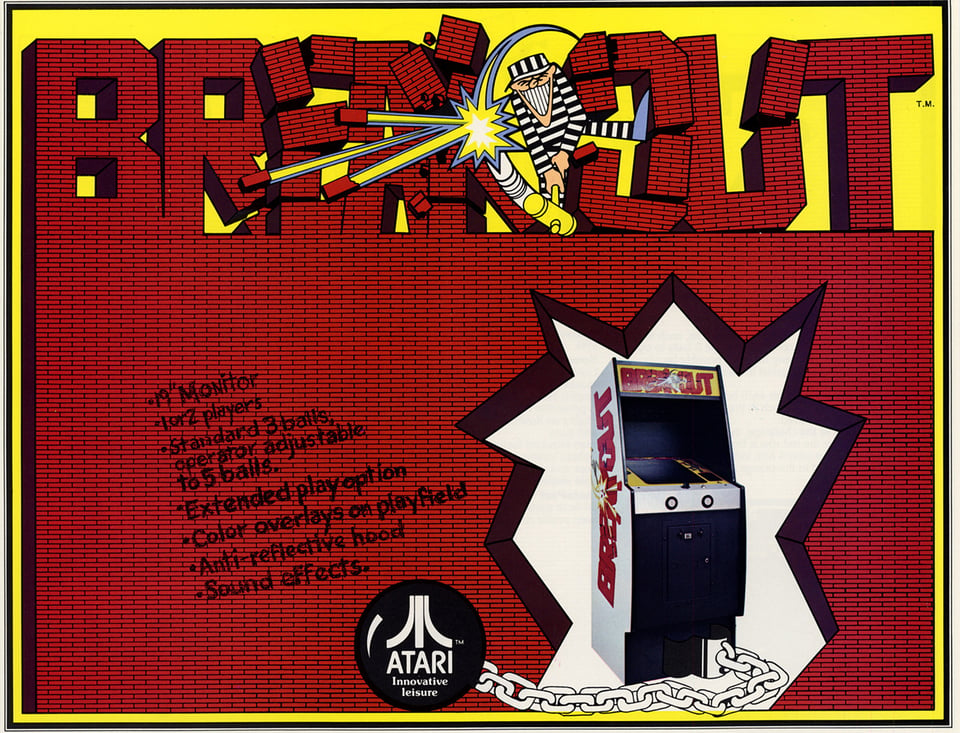
Back in these days and the years that followed, a big transition was happening in the amusement arcades: Videogames were the cool new kid in town and pinball machines had to up their game. For at least a decade, the relationship between the two was caught between distrust and competition on one hand, and mutual inspiration as well as a formed alliance on the other.
Pinball design became a lot more interesting after videogames entered the scene. Videogames though, without any history of their own yet, had to build a foundation, a starting point made out of basic elements to kick off its surprising journey. So why not begin with paddles and balls then?
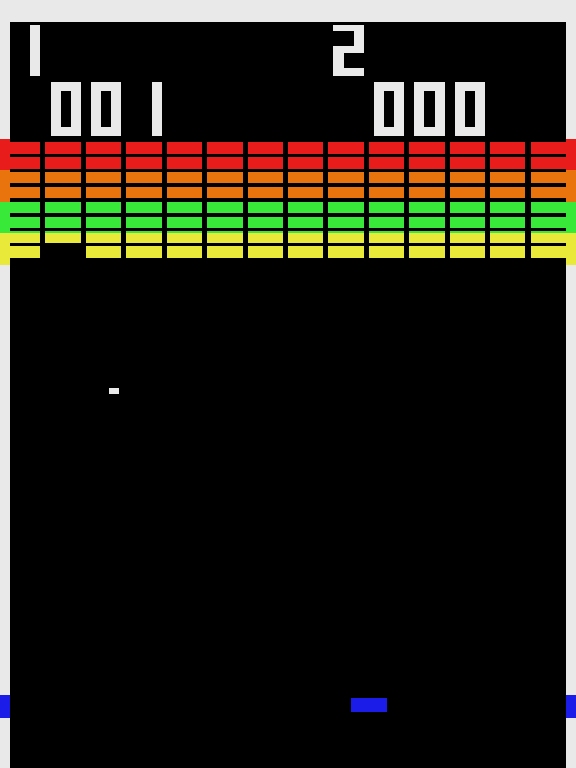
Inspiration went both ways in the late 1970s and early 1980s, and not only because of beefed-up pinball action and successful videogames that received their respective pin variants. Designers like George Gomez or Eugene Jarvis were transitioning between the two areas as if would be the most natural thing in the tech entertainment business world. For a while, the two industries, one fledgling and one flailing, almost seemed to become one single strong entity. It wasn’t to be, as we know today, but at least the dispute fortunately dissipated after a while. Videogames went on to become one of the most successful entertainment industries ever, thereby massively influencing pop culture. Pinball eventually — after a worrying struggle — found a new life thanks to its resilient niche supported by dedicated fans.
This edition of The Ball is Wild 🪩 pinball newsletter is about the celebration of the brick-breaker genre. But it’s also a nod to a time when pinball and videogames shared a startling bond, a strong and turbulent relationship. Enjoy!
IN THIS EIGHTH EDITION:
Editorial: Brilliant brick breakers
Look at the book: Pilgrim in the Microworld (1983)
Videoballs: Vaporwave Pinball
Heavy machines: Portal pinball
EDITORIAL:
Brilliant brick breakers
In the beginning, there was Pong. It wasn’t the very first videogame, mind you, but the one who started an industry. Pong was mandatory two-player. And it was a paddle-and-ball game. If you think of it, it was multiplayer pinball, really. It might have been inspired by those head-to-head machines which were mostly released in the 1960s and 70s. Atari’s Pong is a crude and simple version of that, but the resemblance is quite obvious.
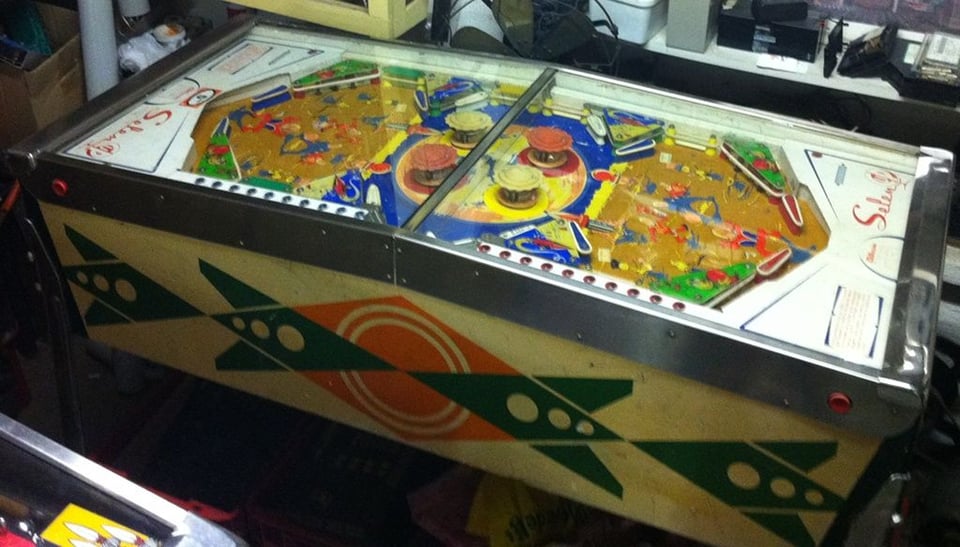
Pong was soon split into many variations although the changes to the game were miniscule. Many people who were at least children during the 1970s have a good statistical chance of remembering many of those Atari knock-offs that were spread across North America, Europe and beyond. Most of them shared the very same games: Official or inofficial Pong and some minor remixes of the game.
Eventually, only one of those remixes stood out: The single player variant that soon became a hit on its own: Breakout from 1976. Considering the very first videogame craze initiated by Pong, it took Atari quite a long time to see the potential of its successor. Because of that, it’s important to know that Breakout was preceded by a similar yet rudimentary version of the same idea. Fortunately for Atari, Ramtek's Clean Sweep (1974) was soon forgotten, and the path was clear for Breakout to slowly create its own videogame genre. Born was the brick-breaker!
Japan pushing forward with Arkanoid
Since Space Invaders (1978), the nascent videogame markets of Japan and the US created a back and forth between the two nations, with each of them coming up with several big hits during the Golden Age of arcade videogames. Breakout was successful but not one of those breakthrough titles that went on to become all-time classics. But it was big enough to get the competition interested. Japanese game giant Taito came up with its own brick-breaker version: Arkanoid. Arkanoid was only released in 1986, a decade later, which at least meant a huge leap in technical prowess. Put back-to-back, the original is very basic and crude in comparison. The Japanese brick-breaker and its immediate sequel, Revenge of Doh from 1987, have pristine graphics with vibrant colors, accompanied by sharp sound effects. These games set a high new standard on what a brick-breaker would look, sound and play like. This would hold for many years.

I am amazed how much fun especially the second part of Arkanoid is even today, when played on my Taito Egret II Mini, a neat tabletop version of the well-known Japanese arcade cabinet from 1996. There was no question that I would also buy the additional controller that features a trackball and a spinner.
The spinner is key when playing brick-breaker games, and can be considered their optimal input device. Both titles and their successors, the Breakout and Arkanoid series respectively, use spinners in their original arcade versions. But every version of a brick-breaker game benefits from this type of input. The Famicom (Japanese NES) port of Revenge of Doh even comes packed with a bespoke rotary controller.
Input device tip: If you can’t use a spinner, always play with a mouse. Controlling a brick-breaker with a gamepad is usually clunky and frustrating. Try thus to stay away from Breakout-likes that offer you no other device choice.

Blue, red, and many other pills
Arkanoid not only stood out because of its improved presentation and smooth gameplay, but also thanks to its power-ups (and power-downs): When you break special bricks, you free certain types of pills. Each color has a different effect. There is one which makes your paddle bigger, one that slows the ball down, and another that starts a multiball (that is very likely to overwhelm you). One of the best effects has to be the transformation of your vanilla paddle into a slick little war shuttlecraft with endless ammunition that can simply shoot all the bricks down.
The third arcade instalment, Arkanoid Returns from 1997, (also included in the Egret II Mini games expansion) lets many of those pills loose. It has hence the most easy-going gameplay experience of the whole series. This is emphasized by the smooth jazz-rock soundtrack that elates the player breezing through the levels.
Nintendo’s brick-breaker home console
Power-ups are also included in another brick-breaker: Crackout (1991) for the NES, where you not only fight against walls, but also throw your balls against cute monsters who would then give away power-ups. At first glance, Crackout seems like an outlier game that was just another Breakout-like, with no successors, prequels or ports whatsoever. Quite the opposite! Crackout is just the one singular game out of a long-lasting series that made the jump into the West. Originally called Block Kuzushi, this title was originally released way back in 1979 for the Japanese home market as a dedicated device, probably as the first Japanese reaction to Breakout. Fully named Color TV-Game Block Kuzushi, it was Nintendo’s first home console game that was produced and released without the help of partner companies.
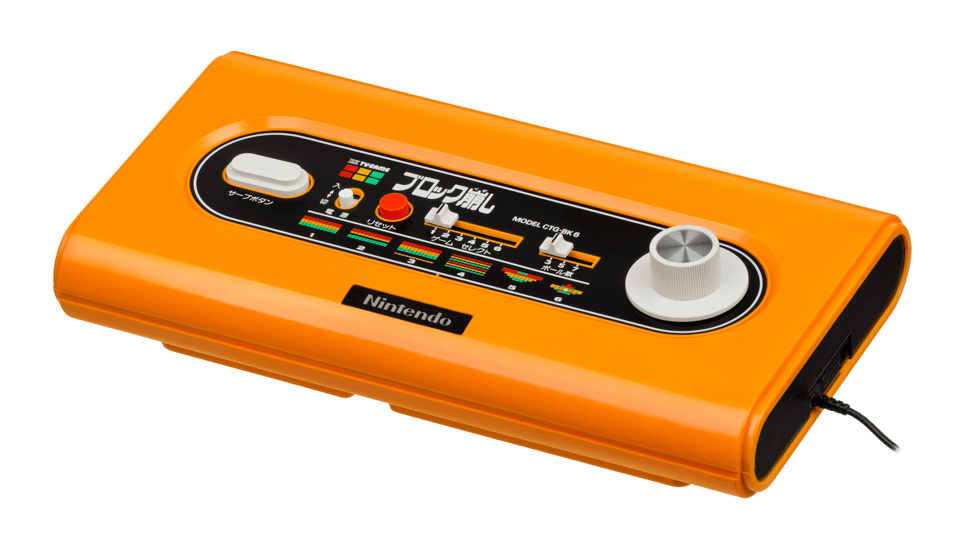
In the years to come, several Block Kuzushi games were made for the arcade as well as for different home consoles, including SNES, Playstation 2 and Nintendo DS. English online sources for this series are patchy but judging from several videos and a few articles, the Kuzushi series seems to be quite varied. The SNES game, for instance, introduces different characters and a background story, whereas the arcade version is basically just a face-lifted version of the usual brick-breaking action.
Brick is back
The 90s and 2000s mostly sleep through brick-breakers. There are a few remakes and updates of the classics here and there, but almost no one seems to be really interested in reviving the concept. Has it become too basic? We are, after all, speaking about a variation of one of the first videogames ever. But it was only a matter of time: In 2012, the new indie outfit Tribute Games, founded by former Ubisoft employees in Montreal, release the charming Wizorb, a brick-breaker RPG hybrid. It stars an old wizard conjuring himself as a paddle and being able to use special powers. Strikey Sisters (2017) works in a similar vein: Although the protagonist doesn’t need a paddle anymore and instead shoots the balls with her own hands, it’s also all about pixelated bricks, dungeons, monsters and a range of special effects.
One of my favorite modern Breakout-like is Hot Pink (2018), a fluorescent neon celebration of light and action, with procedurally created levels. The bricks come down at you step by step, just like in Space Invaders (1978). A simple, yet clever idea that wasn’t used in this genre before. Multiballs have more impact in Hot Pink and can be sustained longer by the player although it’s still not easy to pull this off. The only downside are rogue bricks that sometimes catch you off guard and at some point can’t be cleared anymore. That’s a problem because Game Over doesn’t only come when you drain your (last) ball but also when a brick collides with the lower border of the screen.
A strange yet intriguing variant of the brick-breaker concept is Drawkanoid (2020) where you, yes, draw your paddle every time the ball comes at you. It is during these short instants that the game goes into a slow motion state for about a second or two. Fail to draw a paddle that then collides with the ball, and the ball — of course — drains. Drawkanoid has an interesting concept but is unfortunately not really fun to play. Even weirder is a failed marketing stunt for the game in form of a variant of it called Drawkanoid: Review Breaker. The story behind this special version is quite convoluted: The developers tried to raise awareness for digital game key theft and the illegal reselling of them. What you do in Review Breaker is not breaking blocks, bricks and geometric shapes, like in the main game, but instead smash real Steam reviews. Maybe the whole game should have been like that in the first place?
Behind the paddles and the blocks
What happens when the Pong or Breakout ball goes on an adventure beyond his usual boundaries? This idea was explored by the highly talented Austrian indie game developer stuffed wombat in 2021. Qomp lets you control the ball directly, that is without a paddle. This happens by changing the diagonal direction the ball takes by pressing a button. Once you hit a wall, the horizontal direction of the ball switches, too. There is almost no brick breaking here, yet qomp feels distinctly like a Breakout-like. One that just so happened to move on to another dimension, behind the curtain, and beyond the known playspace. A few years later, Atari got involved and probably bought the rights off of stuffed wombat. 2024 saw a sequel created by another developer.
Speaking of brick-breakers and Austrian devs: There is another talent who created his own take on the genre already in 2014: Martin Mauersics (German-speaking readers: I portrayed him a few months back). Throw Out lets you use your paddle on all four sides of a level although this changes all the time. There are hidden rules, gravity behaving differently, moving bricks, and many more modifiers that remix the basic game every few minutes. This is Mauersics’ great game design handwriting. Do consider also trying and buying his opus magnum so far, the clever puzzle shmup Eigengrau.
More!
Still want more of the good stuff? Let’s go. If you liked the idea of blocks coming towards you, like in Hot Pink, and you also enjoy Vampire Survivors with all it’s many upgrades, I am obliged to nudge you towards Breaking Survivors.
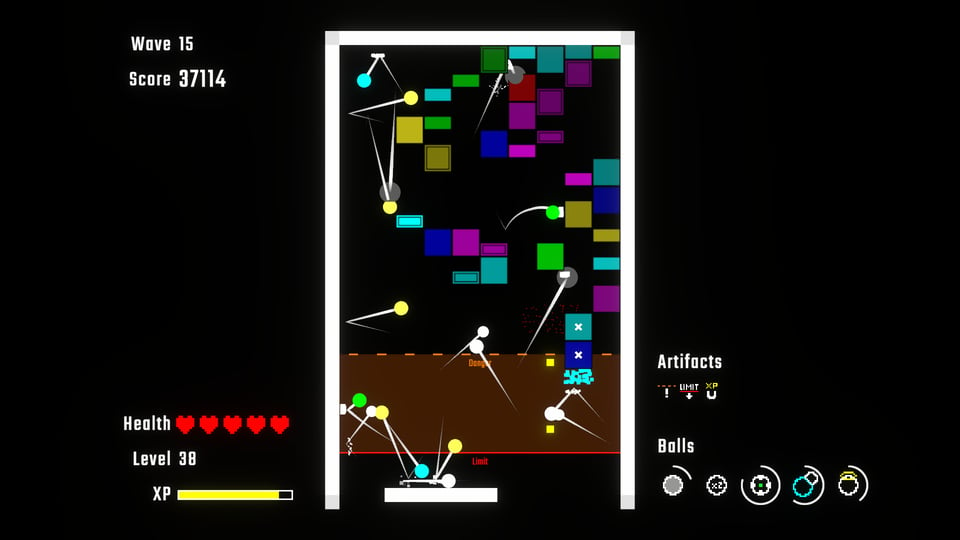
An audiovisual feast is Bot-Break! (2022) which only consists of one level but still has so much to offer. It casts your paddle as some sort of lauch pad for a tank-like spaceship that needs to gets pushed up into the eponymous bot. You not only bounce the tank ship but also thrust it into the air — which is needed because otherwise you can’t even reach the bot. Trust me when I say Bot-Break! is tremendous fun and also not easy to clear. It will take you at least a few attempts. If you now think that you should probably check out other games by Cursed Bootleg, the developer behind Bot-Break!, you would be right. Also, he even did another brick breaker (with beat ‘em up elements mixed in) set in feudal Japan called Siege of Osaka (2022).
Back to Breakout
Coming full circle, there are also new games that carry the original brand: Breakout: Recharged (2022) is a well-done amalgam of the upgrade system, the slowly descending blocks, and also enemies that shoot projectiles at your paddle (see below).
Disappointing, however, is Breakout Beyond that was just released recently. It features the neat idea of tilting the action 90 degrees clockwise (much like in Siege of Osaka) but otherwise falls flat in almost every respect.
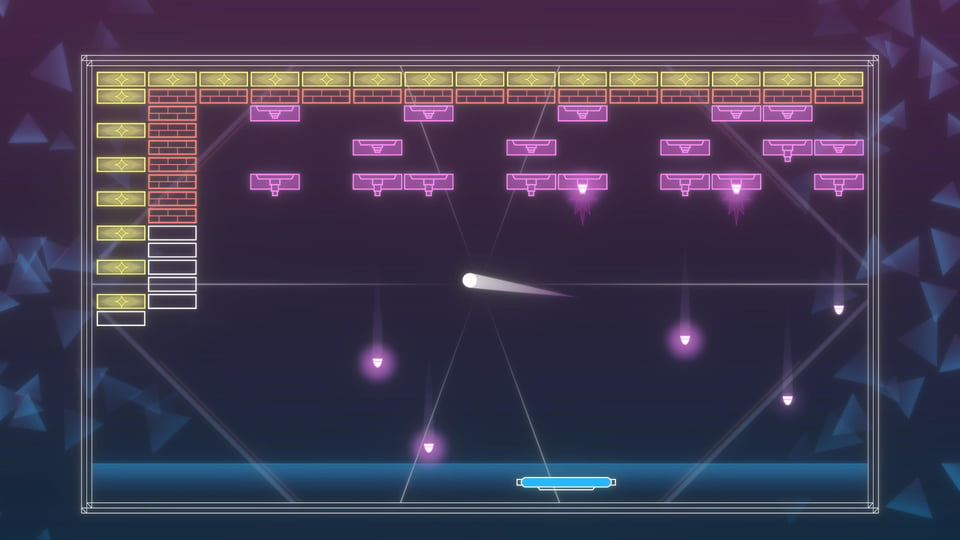
By far the easiest way of enjoying a brick-breaker is by simply typing “breakout game”, “atari breakout” or “brick breaker” into Google Search. This brings up a free game called Block Breaker. What started as an easter egg in 2013 is now this built-in mini game, just like with similar Google recreations (Pac-Man, Minesweeper, etc.). It’s simple but entertaining, with lots of cute little effects. Perfect for improving your next lunch break.
Still not enough?
This Wikipedia page on Breakout clones has you covered.
LOOK AT THE BOOK:
Pilgrim in the Microworld (1983)
The ultimate book on Breakout (not only because it’s the only one for that matter) is without a doubt Pilgrim in the Microworld. Its author David Sudnow, a sociologist professor, writes about his experience completely indulging in the game which he first discovered after picking up his son at an arcade. For it being such a unique project, the book understandably gets rediscovered every once in a while by various videogame culture people. In 2020, Pilgrim in the Microworld received a reprint by US mini publisher Boss Fight Books, but if you are having a hard time accessing/buying it like me, the original book is also available as a PDF here. You can get the Boss Fight reprint also as an eBook though which features a new foreword and a fresh edit.

VIDEOBALLS:
Vaporwave Pinball
Just out of the videogame development oven is a new video pinball game that embraces the meme-genre of Vaporwave which was a hip and ironic celebration of trashy 90s internet culture, glitch art, Greek statues and various other things in the early 2010s. Vaporwave Pinball consists of five tables that are embedded in places like indoor swimming pools or an open space with a smooth checkered black-and-white floor. On each table, you can alternate between four different level setups that change once you hit certain targets or drain the ball.
Vaporwave Pinball by Jamie D aka Mixtape Games UK is about “inhabiting relaxing, liminal locations and playing lo-fi, casual video pinball”. It wants to be “less of a simulation and more of a ‘stimulation’” as well as “chill as f*ck”. The visuals are spot-on regarding the Vaporwave aesthetics, and the game is good fun for at least half an hour. It also doesn’t overstay its welcome. I’m just not completely sure about the chill and relax thing. Although it’s not throwing you off, Vaporwave Pinball is still not super easy. You sometimes drain quite a lot due to fast rebounds from low hanging obstacles, and there is still a highscore on every table that challenges you at least a bit. All in all though it’s a fun and welcome addition to the (still too small) range of fantastically unconventional video pinball games.
HEAVY MACHINES:
Portal pinball
To finish off this already pretty extensive edition of The Ball is Wild 🪩 pinball newsletter, there is one more topic I want to share with you right here, right now: The famous Portal videogame series is receiving its very own physical pinball machine! This news comes during the 10th birthday of the digital Portal pinball creation developed and published by Zen Studios in 2015 which is accessible through different versions of their pinball software frameworks that have been released throughout the years (like Pinball FX3).
The company behind physical Portal pinball is Multimorphic which innovated the market with its adaptive, modular pinball concept starting in the mid/late 2010s. Called the P3 system, you need to buy a whole pinball cabinet only once and then just get upgrade packs for new games. Different games can be swapped within the same pinball cabinet, keeping the experience fresh. This, of course, applies mostly to operators who want to lure in pinball people to their venues without the need of buying big new machines all the time. But it’s also an attractive concept for home owners who lack space.
There is no release date on P3 Portal pinball yet, but the project is already very well documented and has prototypes built and shown. You will be able to play the storylines of both Portal 1 and 2, and the whole feature set will be more extensive than with previous P3 tables/kits.
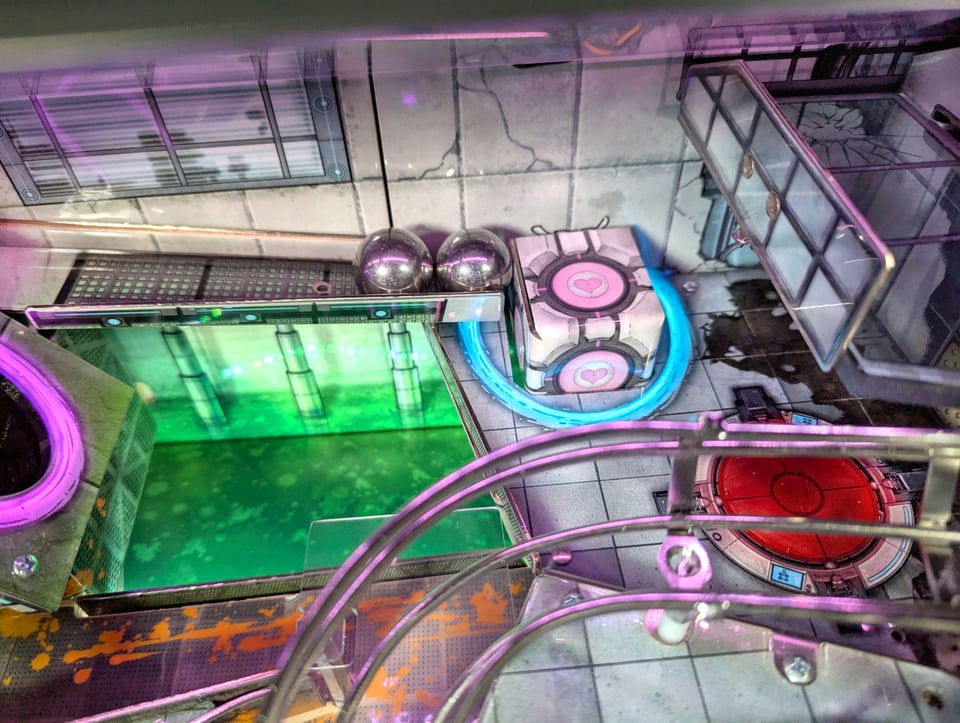
This was issue #8 of The Ball is Wild 🪩
What are your thoughts?
You can get in contact by hitting reply, or reaching out on Bluesky, Mastodon, or Instagram.
Back issues:
Issue #7: Marvellous Marble Machines (3 December 2024)
Issue #6: Spooky Silverballs (30 October 2024)
Issue #5: Balancing balls (30 September 2024)
Issue #4: Pinball in the public (31 August 2024)
Issue #3: Machine manipulation (29 July 2024)
Issue #2: Examining the pinball (1 July 2024)
Issue #1: Let’s get this ball rolling (10 June 2024)
General information about this newsletter and the person behind it is available here.
If you like The Ball is Wild 🪩, consider spreading the word to friends, family and colleagues who might be interested. Subscribing is and will continue to be free.
New issues will again be published on a (more or less) monthly basis. I promise (also to myself) that upcoming editions will be a bit shorter than this big Spring write-up. But maybe you enjoyed the scope! Whatever the case, I’ll see you in May. Until then, let’s break some bricks 🧱